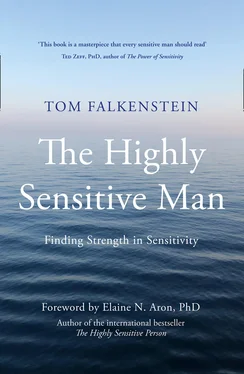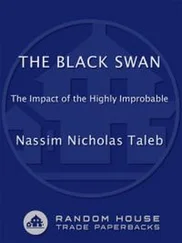Of course, we have been talking about the “new man” for decades, embodied by the likes of “metrosexuals” and style-conscious figures like David Beckham. There is no question that society’s ideas around male identity have changed over the past decades, and there are plenty of indicators to back this up. For instance, fathers now spend on average eight hours a week on childcare; this is three times as much as was reported in 1965. And they spend on average ten hours on household chores, up from four hours in 1965. 22And yet our image of “new men” is still heavily influenced by those classic, traditional attributes: professional success, stamina, status, performance, self-control, and heterosexuality. This is backed up by numerous psychological studies over the last forty years that tell us that, despite huge social change, the stereotypical image of the “strong man” is still firmly with us at all ages, in all ethnic groups, and among all socio-economic backgrounds. In the face of problems, men tend not to seek out emotional or professional help from other people. They use, more often than women, alcohol or drugs to numb unpleasant feelings and, in crises, tend to try to deal with things on their own, instead of searching out closeness or help from others. 23A new metrosexual masculinity that focuses simply on external appearance and the existence of paternity leave in many countries (ninety-two countries, but not the United States) have done very little to change this.
The socialization of men, so essential to their identity, lifestyle, and behavior, seems to be a decisive part of the problem. When we talk about socialization, we mean the process of integrating and adapting to the society and culture that surrounds us, through, for instance, the family, school, friends, the church, or the media. Early on in his life, a boy will begin to take on those gender-specific behaviors, attitudes, values, norms, and ideologies that the society in which he is growing up deems to be masculine and acceptable. The unfortunately still popular blue onesie is just the beginning of this process and is a public symbol of a socialization that often takes far more subtle forms.
We know, however, that the internalization of particularly restrictive socially masculine norms can have negative consequences on how a man feels. 24This happens when he begins to feel that the way he is does not fit with the way he thinks he should be . We call this “gender role strain” and “gender role conflict.” Both concepts are used to measure and describe the emotional stress and conflict that men feel when they suffer emotionally from internalizing restrictive and unachievable masculine norms. 25Jim O’Neil, the psychology professor and pioneer who first described gender role conflict, described the concept as follows: “Gender role conflict (GRC) is defined as a psychological state in which socialized gender roles have negative consequences for the person or others.” 26Psychologist Michael Addis also uses this concept in his work, showing that it is precisely those men who have strongly internalized traditional masculine norms and values—such as self-sufficiency, strength, and independence—who have a higher risk of suffering from depressive episodes and are less likely to seek professional help to deal with them. 27It seems that old but still active adages such as “boys don’t cry” and men need to “keep a stiff upper lip” can actually be detrimental to men’s physical and mental health. Certainly, all men could benefit from loosening the restraints put on them by traditional masculine norms and values, but unfortunately, the fear of not being manly enough holds them firmly in place.
The Fear of Not Being Manly Enough
O’Neil believes that men’s fear of not appearing to be masculine enough—or even worse, feminine—is often the main source of the hard and rigid armor that men put on, or allow society to put on them. He argues that this fear of the feminine is connected to strong, negative feelings that are related to stereotypes about feminine values, beliefs, and behaviors and that these stereotypes are formed during our childhoods by parents, peers, and social norms. Men’s conscious and subconscious fear of the feminine has been a consistent theme in academic literature for years. 28
I often observe this in my work with male clients—men who quickly feel ashamed when they believe that they haven’t behaved in a way that, in their opinion, fits with the behavior of a “real man.” The process often begins in childhood. Shame is an intense emotion and a powerful tool of socialization. When we feel ashamed, we often connect this with a fear of being shut out, of no longer belonging to a group. Among prehistoric societies, this was a matter of life or death.
But when the internalization of traditional masculine values and ideals has reached such a pitch that it has clear and grave psychological and physical consequences, when it even leads to men dying earlier because they seek out medical help too late or are unaware that they’re even ill, when they won’t ask for help or confide in anyone else, then it is surely high time that we question and broaden our definitions of these traditional masculine values.
I believe that the highly sensitive man has a key role to play in this, because his inborn high sensitivity and the emotionality and subtlety of feeling that comes with it automatically challenge traditional masculine norms, values, and behaviors, such as hardness, toughness, stamina, competitiveness, and self-control. And he does this without necessarily being conscious of it. He does it just by being himself. This is the vital role that the highly sensitive man can play in society—challenging taboos around vulnerability, sensitivity, empathy, and, in particular, emotionality. And all men can profit, be they young or old, heterosexual or homosexual, highly sensitive or not highly sensitive. If a more authentic, holistic, and multifaceted form of masculinity could emerge because of this, a form that would allow all men in society to be sensitive and emotional without having to feel shame, anxiety, or a sense of inferiority, then we all win.
What We Define as Masculine is Not Set in Stone
Society’s view of how a man should be and what attributes are desirable and attractive in him is something that is more flexible than we think. In her book A History of Male Psychological Illness in Britain: 1945–1980 , historian Allison Haggett, Ph.D., describes the development of men’s psychological problems in the United Kingdom since the Second World War. 29When I talked to her, she explained to me that she finds the current, very narrow definition of masculinity in the Western world to be “problematic and restrictive,” referencing numerous psychological and medical studies on men’s health.
Haggett also describes how our understanding of typical masculinity has changed radically throughout history and says that, from a historical perspective, it is much harder to define than we might suppose. In her book, she argues that masculine attributes are first and foremost socially constructed and not biologically determined. They are, therefore, prone to change and have often done so in the past. She describes how, during the Georgian era (1714–1830), just before the start of the Industrial Revolution in Great Britain, the picture of a desirable man was completely different from the image we have today. At that time, masculinity was equated with wisdom and virtuousness. Not only was it socially acceptable for a man to express himself emotionally, it was positively desirable. The Georgian man was not afraid of being scorned for showing emotion. According to Haggett, this led to a culture of introspection among men, in which it was socially acceptable to be self-reflective and contemplative.
Читать дальше












